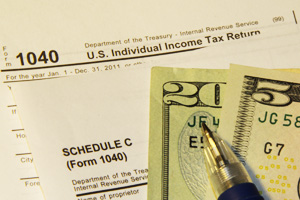
You can calculate the self-employment (SE) tax
- Using Schedule SE. This schedule is very self-explanatory and easy to follow, anyone who able to read can perform the calculations of the self-employment tax without much of difficulties.
- Manually using the following formula
Formula for self-employment tax computation as follows
| Gross income from SE | |
| Step 1 | Less: Business expense deductions |
| Equal: Net SE income or Net profit (loss) | |
| Step 2 | Multiply: 0.9235 (100% - 7.65% = 92.35% or 0.9235) |
| Equal: Net earnings from SE | |
| Step 3 | Multiply: 10.4% (Ceiling- $106,800) and 2.9% 2 |
| Equal: SE tax |
How to report multiple self-employment business?
Self-employed individuals with multiple businesses do not need to report them separately. Instead, they should total income or losses from all businesses up and include it on their Schedules C. This is also true for a married couple where husband and wife have their own separate businesses. Therefore, as long as their filing status will be married filing jointly, they should combine their income together for tax purposes.
What is the Self-employment tax rate?
2For 2012, the SE tax rate is 13.3 % and consist of :
- A Social Security Old-Age, Survivors, and Disability Insurance (OASDI) – 10.4%
- A Medicare Hospital Insurance (HI) – 2.9%
Are there any limits (ceilings or floors) in self-employment tax calculations?
2Ceiling - a Social Security OASDI is limited to $110,100 for 2012, but Medicare HI has no limits. This means that a self-employed individual will be subject to Social Security tax no more than $11,450 ($110,100 x 10.4%) for the tax year of 2012.
Floor - if your net earnings from SE are less than $400, you do not need to calculate the SE tax for the tax year at all.
1Example 1, to illustrate let’s assume that a self-employed individual has total gross receipts for the tax year of $57,973. He also has the following business expenditures, such as
- advertising - $3,000,
- car expenses - $1,131,
- fees - $54,
- depreciation deduction - $1,321,
- insurance - $636,
- office expenses - $1,752,
- rent - $6,900,
- supplies - $9,284,
- licenses - $250,
- utilities - $10,043,
- shipping - $2,708.
Calculation of the self-employment tax
| Example 1 | ||
| Gross income from SE | 57,973 | |
| Step 1 | Less: Business expense deductions | (37,079) |
| Equal: Net SE income or Net profit (loss) | = 20,894 | |
| Step 2 | Multiply: 0.9235 (100% - 7.65% = 92.35% or 0.9235) | x 0.9235 |
| Equal: Net earnings from SE | =19,296 | |
| Step 3 | Multiply: 0.133 2 or 13.3% | x 0.133 |
| Equal: SE tax | = 2,566 |
2In the example, the amount of Net earnings from SE does not exceed the ceiling, therefore, there is generally no need to separate 13.3% of SE tax by SS and Medicare portions.
Example 2, let’s assume that the self-employer from the example 1 earned $160,000 in gross receipts and has business related expenses of $30,000.
| Step 1, | $160,000 - $30,000 = $130,000 – Net SE income |
| Step 2, | $130,000 x 0.9235 = $120,055 - Net earnings from SE |
| Step 3, | 1) $110,100 2 x 10.4% = $11,450 - Social Security 2) $120,055 x 2.9% = $3,482 - Medicare $11,450 + $3,482 = $14,932 - Total SE tax |
2 In this example the Social Security limitation of $110,100 has been applied.
Calculate deductible part of the self-employment tax
In order to calculate the deduction, you need to perform the following two multiplications from example 2 1) $11,450 x 59.6% or 0.596 and 2) $3,482 x 50% or 0.5. Then add the results $6,824 + $1,741 = $8,565 which will be entered on Form 1040, line 27.
In addition to SE tax, a self-employed individual might need to pay the income tax if his standard (itemized) deductions won't cover his Adjusted Gross Income (AGI).
